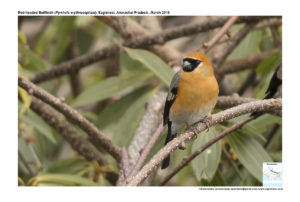Red-headed-Bullfinch

Red-headed Bullfinch Pyrrhula erythrocephala
Etymology:
- Pyrrhula : Greek word purrhoulas worm-eating bird ; Pyrrha– Flame coloured
- Erythrocephala : Greek word eruthros-red; kephalos –headed { Red Headed}
Vernacular names: Lepcha: Kobyu
Distribution in India: Resident of Himalayas in India.
Description: Size of 16-17 cm; wt. of 18-28 g. It is a medium-large bullfinch with short, curved bill and long, notched tail. The male has lower forehead and lores to behind eye and across cheek to chin black, narrow pale buff band across upper forehead; forecrown to nape and side of neck variably pale to deep orange, rest of face to center of throat pale yellowish-orange, slightly richer on ear-coverts; upperparts plain grey or deep ash-grey, rump white, uppertail-coverts and tail black, glossed purplish; upperwing black, median coverts broadly tipped pale ash-grey, greaters edged purplish-black at base and inners broadly tipped pale grey, passing to outer 2–3 narrowly tipped white, flight-feathers glossed deep bluish-black; breast, upper belly and flanks orange-rufous, rest of underparts whitish, washed orange; iris dark brown; bill dark lead-grey or black; legs pale pinkish-brown. Female has forehead and lores to chin black, bordered by narrow pale or whitish band on upper forehead; forecrown grey, hindcrown to nape and side of neck pale greenish-yellow, upperparts deep grey, rump white; uppertail-coverts and tail and wing as on male, but median coverts grey, tipped paler grey, greater coverts broadly tipped grey on inners and narrowly white on outers, flight-feathers black, inner secondaries and tertials glossed blue-black; underparts grey, tinged buffish-brown, belly to undertail-coverts white; bare parts much as for male. The juvenile is like female, but browner, head is warm brown or tinged rufous-buff, upperparts are tinged grey, upperwing-coverts are broadly tipped deep buff or rufous-buff, breast is pale greyish-olive or yellowish-olive, and rest of underparts are warm brown.
Habitat: It is found in breeding season in lower montane and submontane dense conifer forests at 2400–4200 m in Himalayas. In non-breeding season found in similar habitat and also in oak and rhododendron and scrub in foothills, often near streams or rivers in willows, undergrowth and scrub; usually above 1500 m.
Food Habits: It eats seeds, buds, willow catkins, berries, mostly blackberries, and nectar from rhododendron flowers and arthropods. It forages low down in bushes or vegetation or on the ground; fairly lethargic, spends long periods in foraging in one place before moving on, or may sit motionless in bushes. Usually in pairs and in small groups, post-breeding flocks may be mostly of males.
Breeding Habits: Breeds in May-Aug in India. The nest is a cup of twigs, plant fibers, roots and lichen placed above ground in small tree. It lays a clutch of 3–4 eggs. The incubation is done by female.